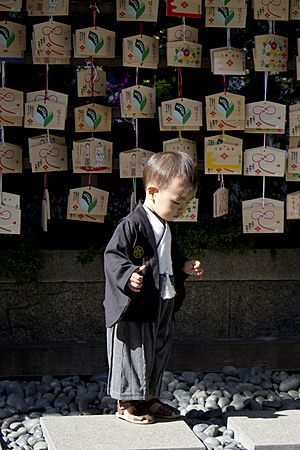Shichi-Go-San facts for kids
Shichi-Go-San (pronounced Shee-chee-go-sahn) is a special celebration for children in Japan. Its name means "seven-five-three," which refers to the ages of the children being celebrated. Every year on November 15, families gather to give thanks for their children's health and to wish them a bright future. This important event marks key stages in a child's early life.
Contents
Why Celebrate Shichi-Go-San?
In the past, it was harder for children to grow up healthy. Because of this, people in Japan started special celebrations to mark important ages. These celebrations began during the Edo period (1603-1868). The ages of three, five, and seven were chosen as special milestones. Celebrating these ages showed how much families valued their children's growth and well-being.
How Families Celebrate
On this special day, children dress up in beautiful traditional clothes. Girls often wear colorful kimono, and boys might wear a hakama (a type of wide-legged pant) or a haori (a formal jacket).
Visiting a Shrine
Families usually visit a Shinto shrine. There, they pray for their children's health and happiness. It's a time to thank the gods for protecting their kids. Many families also take professional photos to remember this special day. These pictures become cherished memories for years to come.
Chitose-Ame: The Candy of a Thousand Years
A unique part of Shichi-Go-San is a special candy called chitose-ame. This candy is long, thin, and comes in red and white colors. It is often given in a bag decorated with symbols of good luck, like cranes and turtles. The name chitose-ame means "thousand-year candy." It symbolizes a wish for the child to live a long and healthy life. Eating this candy is a sweet way to celebrate their growth.
Related Japanese Festivals
Images for kids
-
Shichi-Go-San ritual at a Shinto shrine
See also
 In Spanish: Shichi-Go-San para niños
In Spanish: Shichi-Go-San para niños





